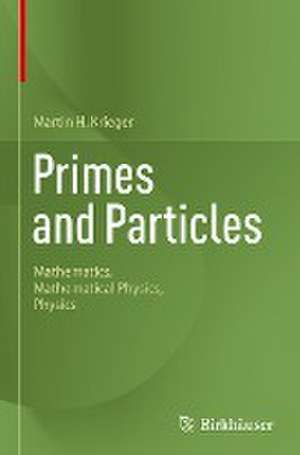Primes and Particles: Mathematics, Mathematical Physics, Physics
Autor Martin H. Kriegeren Limba Engleză Hardback – 23 feb 2024
Preț: 637.93 lei
Preț vechi: 750.50 lei
-15% Nou
Puncte Express: 957
Preț estimativ în valută:
122.08€ • 126.73$ • 101.80£
122.08€ • 126.73$ • 101.80£
Carte tipărită la comandă
Livrare economică 22 martie-05 aprilie
Preluare comenzi: 021 569.72.76
Specificații
ISBN-13: 9783031497759
ISBN-10: 3031497759
Pagini: 102
Ilustrații: XVII, 102 p. 9 illus., 4 illus. in color.
Dimensiuni: 155 x 235 mm
Greutate: 0.35 kg
Ediția:2024
Editura: Springer Nature Switzerland
Colecția Birkhäuser
Locul publicării:Cham, Switzerland
ISBN-10: 3031497759
Pagini: 102
Ilustrații: XVII, 102 p. 9 illus., 4 illus. in color.
Dimensiuni: 155 x 235 mm
Greutate: 0.35 kg
Ediția:2024
Editura: Springer Nature Switzerland
Colecția Birkhäuser
Locul publicării:Cham, Switzerland
Cuprins
- 1. Introduction. - 2. Why Mathematical Physics?. - 3. Learning from Newton. - 4. Primes and Particles. - 5. So Far and in Prospect. - 6. Creation: When Something Appears Out of Nothing. - 7. Packaging “Spectra” (as in Partition Functions and L/ζ-Functions) to Reveal Symmetries in Nature and in Numbers. - 8. Legerdemain in Mathematical Physics: Structure, “Tricks,” and Lacunae in Derivations of the Partition Function of the Two-Dimensional Ising Model and in Proofs of The Stability of Matter. - 9. Mathematical Physics.
Notă biografică
Martin H. Krieger was trained as an experimental physicist at Columbia University. He is a Fellow of the American Physical Society. Krieger has taught in policy and planning and management at the University of California (Berkeley), Minnesota (Twin-Cities), MIT, University of Southern California, and University of Michigan (Ann Arbor). He has been a fellow at the Center for Advanced Study in the Behavioral Sciences and the National Humanities Center. Krieger is professor emeritus at the University of Southern California. Primes and Particles is his twelfth book. His earlier books include Doing Physics (Indiana, 1992, 2012), Constitutions of Matter (Chicago, 1996), and Doing Mathematics (World Scientific, 2003, 2015).
Textul de pe ultima copertă
Many philosophers, physicists, and mathematicians have wondered about the remarkable relationship between mathematics with its abstract, pure, independent structures on one side, and the wilderness of natural phenomena on the other. Famously, Wigner found the "effectiveness" of mathematics in defining and supporting physical theories to be unreasonable, for how incredibly well it worked. Why, in fact, should these mathematical structures be so well-fitting, and even heuristic in the scientific exploration and discovery of nature? This book argues that the effectiveness of mathematics in physics is reasonable. The author builds on useful analogies of prime numbers and elementary particles, elementary structure kinship and the structure of systems of particles, spectra and symmetries, and for example, mathematical limits and physical situations. The two-dimensional Ising model of a permanent magnet and the proofs of the stability of everyday matter exemplify sucheffectiveness, and the power of rigorous mathematical physics. Newton is our original model, with Galileo earlier suggesting that mathematics is the language of Nature.
Caracteristici
Presents many analogies between physical objects and mathematical structures Shows how mathematics works in mathematical physics and how physics exemplifies mathematics Argues that the mathematical rigor in physics is motivated by various aspects of the physical description of nature
